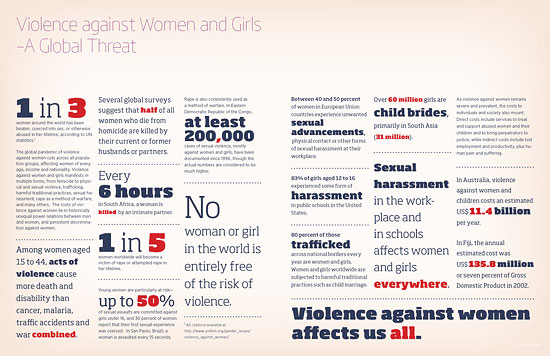It is estimated that 35 per cent of women worldwide have experienced either physical and/or sexual intimate partner violence or sexual violence by a non-partner at some point in their lives. However, some national studies show that up to 70 per cent of women have experienced physical and/or sexual violence from an intimate partner in their lifetime.
In 2012, a study conducted in New Delhi found that 92 per cent of women reported having experienced some form of sexual violence in public spaces in their lifetime, and 88 per cent of women reported having experienced some form of verbal sexual harassment (including unwelcome comments of a sexual nature, whistling, leering or making obscene gestures) in their lifetime.
There are many more statistics where that comes from. So, what is Gender Violence? Any act of gender–based violence that results in, or is likely to result in, physical, sexual or psychological harm or suffering to women, including threats of such acts, coercion or arbitrary deprivations of liberty, whether occurring in public or in private life.”

What can be the causes of thus violence? It can be due to environment, mentality etc.
According to Genderviolence.org, there are many factors that cause someone to be violent. It is not just one cause, there are a combination of factors. A man named Heise created a framework that shows risk factors at four levels; the individual, the relationship, the community and the structural level. It gives someone more of an understanding as to why people are victimized or perpetrators.
Individual factors are biological and personal history factors such as a low level of education, young age, low economic status, and exposure to violence during childhood.
The relationship factors includes level of relationship with peers, intimate partners and family members. family members can pretty much give approval for a man raping a women, making it sound like it is the norm. it is not!
The community factors refers to the tolerance towards gender based violence in schools, workplace or neighborhood. Also, women living in poverty who work or live by themselves are at a higher risk of sexual assault.
Societal factors refer to the cultural and social norms that shape gender roles and the unequal distribution of power between women and men. Violence seemed more prevalent where men have more power making decisions and women do not have easy access to divorce.
So, knowing that there are multiple factors, what can we do to prevent Gender based violence?
We need to bring awareness. Without awareness, it will continue to happen. No one should be victimized. Everyone should have a voice. Because, without a voice the cycle of gender violence will continue and it will be a norm in society which will not help the cause. Don’t give in, speak up!
Citations
Facts and figures: Ending violence against women.” UN Women. N.p., n.d. Web. 1 May 2017.
“Strengthening Health System Responses to Gender-based Violence in Eastern Europe and Central Asia.” 1.3. Causes of gender-based violence | The response to Gender-Based Violence in Eastern Europe and Central Asia. N.p., n.d. Web. 1 May 2017.

